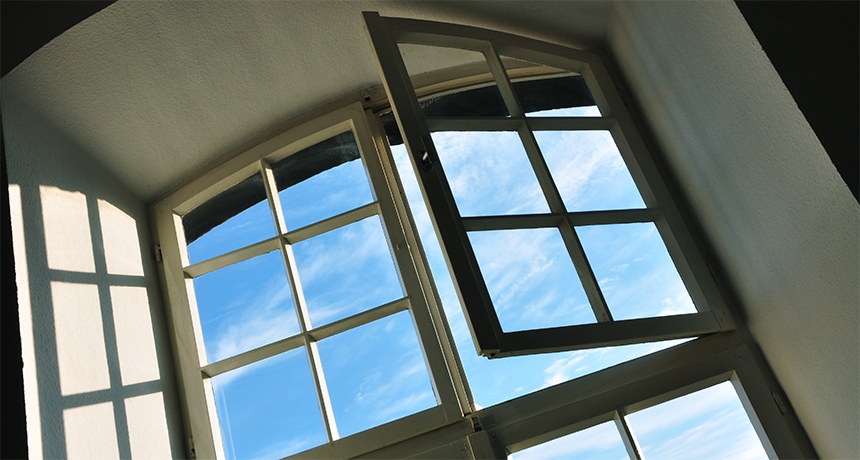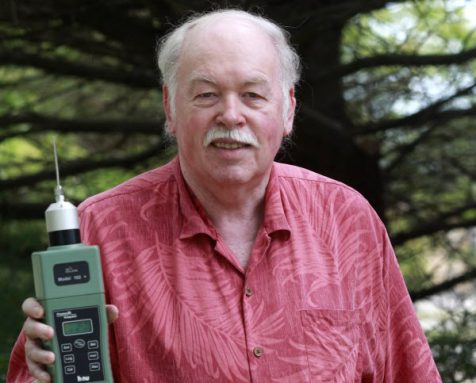Sniffing for bad air
Handheld carbon dioxide sensor can help identify classrooms with unhealthy ventilation rates

The air quality in many classrooms is unhealthy, due to poor ventilation. But simple solutions such as opening a window can help get rid of bad air.
i_love_zou_york/iStockphoto
By Sid Perkins
In the past few weeks, millions of students, teachers and staff have returned to classrooms in schools across the United States. The air quality in many of those classrooms might be unhealthy, thanks to poor ventilation. But a new sensor designed to identify elevated amounts of carbon dioxide could help solve the problem — and maybe even boost test scores, scientists report.
The handheld device developed by a chemist and his colleagues is easy to use: Simply carry it into a room where you want to measure carbon dioxide levels. Once bad air is detected, the solution might be as easy as opening a window.
With every breath you take, you inhale a host of gases, including oxygen. Every time you exhale, you breathe out carbon dioxide (CO2). Both of these gases are a natural part of Earth’s atmosphere.
Nitrogen makes up more than 78 percent of the air; oxygen almost 21 percent. Meanwhile, CO2 makes up only a tiny fraction of Earth’s atmosphere: 0.0395 percent. That means that a mere 395 molecules out of every million in the air are CO2. Yet even though that proportion, or concentration, of this gas in the air is very low, CO2 is very important. Plants use it to grow and make oxygen, which humans and all other animals require.
Odorless and colorless, CO2 comes from many sources. These include volcanoes, rotting vegetation and the burning of fossil fuels such as gasoline, natural gas and coal. Animals also produce CO2 when inhaled oxygen reacts chemically with carbon in the foods they consumed. The average person breathes out between 20 and 25 liters of CO2 each hour.
When a large number of people spend time in an enclosed space like a classroom, CO2 concentrations can increase dramatically. This is particularly true if air circulation is poor, explains Jack Driscoll. He’s a chemist at PID Analyzers. The company, based in Sandwich, Mass., makes equipment used to detect and measure various gases in the air.

PID Analyzers, LLC
When levels of CO2 build up, people may develop headaches or become sleepy, notes Roger Hedrick. He’s an environmental engineer at Architectural Energy Corporation in Boulder, Colo. Elevated CO2 levels can be a sign that ventilation is poor, he notes. And that means that other gases — including noxious, or harmful, ones — might be building up as well. What types of other gases? It could be something as simple as body odor. Or it could be something as potentially dangerous as solvents and other volatile organic chemicals, often referred to as VOCs. These can be emitted by furniture, carpets or paints.
In schools built 15 years ago or more, air in a typical classroom is fully replaced with fresh air between four and six times each hour, says Driscoll. Suprisingly, he notes, the air in some newer schools may be replaced with fresh air only once or twice each hour. The reason: Buildings designed to be energy efficient are more tightly sealed, to lessen the loss of heated or cooled air. This also lessens, however, the removal of any unhealthy air. So exchanging indoor air with air from outdoors can often lower pollutant levels.
The Environmental Protection Agency doesn’t set standards for CO2 concentrations in schools, office buildings or commercial properties such as department stores or shopping malls, says Hedrick. But a professional group called ASHRAE has developed guidelines for many aspects of indoor air quality, including CO2 levels. (Hedrick is the current chairman of the ASHRAE committee that developed these recommendations.) According to those guidelines, CO2 concentrations in a classroom should not rise above 1,025 parts per million. That’s about 2.5 times the average concentration of CO2 in outdoor air.
To help identify stale classroom air, Driscoll and his colleagues developed a device that can easily be used to monitor CO2 concentrations. The walkie-talkie-sized device constantly slurps in air samples. Electronics in the sensor measure the amounts of infrared light absorbed by the air sample at two different wavelengths. One is a wavelength at which CO2 absorbs little if any of the light. At the other wavelength, the gas absorbs a lot of the light. Comparing the light’s absorption at these two different wavelengths provides a measurement of the concentration of CO2 present in a room’s air.
Driscoll described this new CO2 sensor on August 22 at the American Chemical Society meeting in Philadelphia. If the sensor detects that CO2 levels have reached unacceptable limits, then the remedy is often very simple, he notes. For example, school maintenance personnel can often increase classroom ventilation simply by changing dirty air filters or adjusting the speed of the blowers in the school’s heating or air-conditioning system. And the simplest solution at all: For a short time, room windows can be opened slightly.
Besides improving classroom air quality, increasing ventilation could help boost student performance, Driscoll and his colleagues contend. Many previous studies have shown that improved air quality is linked to better test scores, he notes.
Power Words
atmospheric concentrations The concentration of a gas can be measured either as a percentage or as a certain number of parts per million. Gases that are found in very small amounts can even be measured in smaller concentrations, such as parts per trillion.
carbon dioxide A gas produced by all animals when the oxygen they inhale reacts with the carbon-rich foods that they’ve eaten.
molecule An electrically neutral group of atoms that represents the smallest possible bit of a chemical compound. Molecules can be made of single types of atoms or of many different types. For example, the oxygen in the air is made of two oxygen atoms (O2), but water is made of two hydrogen atoms and one oxygen atom (H2O).
volatile organic chemicals, or VOCs Chemical compounds that easily evaporate, or convert from a solid or a liquid into a gas. Many things give off VOCs, including some types of paints, adhesives, new furnishings and office equipment. Concentrations of VOCs can be particularly high in buildings that are newly constructed or recently refurnished or renovated. Few VOCs are toxic but prolonged exposure to those that are can cause long-term health problems, including liver, kidney and nervous system damage — and possibly even some forms of cancer. Short-term symptoms include headaches, nausea and irritation of the eyes, nose and throat.
ventilation A system that supplies a room with fresh air or processes that move air around and between different rooms.
wavelength The distance between one peak and the next in a series of waves, or the distance between one trough and the next. Visible light — which, like all electromagnetic radiation, travels in waves — includes wavelengths between about 380 nanometers (violet) and about 740 nanometers (red). Radiation with wavelengths shorter than visible light includes gamma rays, X-rays and ultraviolet light. Longer-wavelength radiation includes infrared light, microwaves and radio waves.







